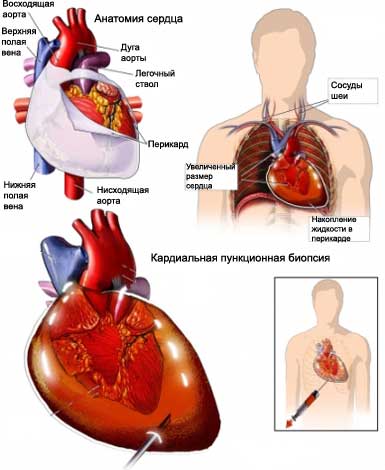Puncture pericardium – Pericardiocentesis
Description pericardiocentesis
Pericardial sac surrounding the heart. It usually contains a small amount of liquid. Pericardiocentesis – selection of the pericardial fluid with a needle.

Reasons for pericardiocentesis
Puncture of the pericardium may be used to treat. If the bag is too much fluid builds up, it can exert additional pressure on the heart – there is cardiac tamponade, a life-threatening disorder. Selection of a certain amount of fluid helps to reduce the pressure on the heart.
Pericardiocentesis may also be used to diagnose the cause of fluid accumulation. The accumulation of fluid known as pericarditis (pericardial effusion). Accumulation can cause infection, cancer, trauma, autoimmune disease or drug use. It may also indicate rheumatoid arthritis, infarct or renal failure.
Possible complications puncture pericardium
If you plan to pericardiocentesis, you need to know about possible complications, which may include:
- Damage to the lungs or heart puncture needle;
- Bleeding;
- Infection;
- Disruption of normal heart rhythm.
Factors, that may increase the risk of complications include:
- Obesity;
- Smoking;
- Excessive alcohol consumption;
- Use of blood thinners or blood clotting;
- Shock.
How is pericardiocentesis?
Preparing for Pericardiocentesis
Puncture of the pericardium can be scheduled or emergency procedure. This may affect the analysis conducted before potseduroy. Before pericardiocentesis can be performed the following tests:
- Blood tests;
- Chest X-ray – to take pictures of structures inside the body;
- Electrocardiogram – test, which detects heart activity by measurement of electrical current through the heart muscle;
- Echocardiogram – test, which uses sound waves (ultrasound), to examine the size, shape and motion of the heart
In the run-up procedure:
- Tell your doctor about taking any medications. A week before surgery you may be asked to stop taking certain drugs:
- Aspirin or other anti-inflammatory drugs;
- Blood thinners, such as clopidogrel (Plaviks) or warfarin;
- You will need to limit your intake of fluids and food before the procedure. The doctor or nurse will give on this issue special instructions;
- If you have diabetes, you need to ask your doctor, how to take the medication before the procedure.
Anesthesia
It is necessary to take a mild sedative, to relax. During the execution of the puncture pericardium you awake. In the area of the needle prick held a local anesthetic. He was numb to the puncture site.
Procedure puncture pericardium
You will lie on the treatment table. In his hand is inserted venous catheter, that supplies sedative. The area of the needle will be treated with an antiseptic. Checking the work of the heart.
The needle is inserted into the chest, which Dr. inches toward the heart. To help guide the needle to the right place to be to use ultrasound, and, perhaps, fluoroscopy. The needle will be introduced only in the pericardium, but not more.
After that, the selection of fluid from the pericardial sac. There can be used a needle or catheter tube, which is inserted into the needle. After selecting or removing the necessary amount of fluid needle or catheter will be removed. Place a puncture pressed for a few minutes, to stop the bleeding.
In some cases, the physician may leave the catheter. This will continue to drain for a few hours or days.
Immediately after the puncture of the pericardium
Held chest X-ray, To make sure, that have not been punctured lung. Within a few hours after the procedure will be regularly checked the pulse, blood pressure and respiration.
Liquid from pericardium sent to a laboratory for analysis.
How long will pericardiocentesis?
About 20-60 minutes.
Puncture pericardium – Will it hurt?
You can feel the pain of needle insertion.
The average hospital stay after a puncture pericardium
Hospital stay can vary from one to several days. If the catheter is to continue draining fluid, to stay in the hospital for a few days.
Keeping the postoperative period after the puncture of the pericardium
After returning home, follow these steps:, to ensure the normal recovery:
- Clean the area of the introduction of the needle once a day with warm water and mild soap. Do not rub the area of the puncture;
- Avoid vigorous activity before the doctor's instructions, especially stress on the upper body;
- After the restoration, you can return to work and daily activities. Also, you can resume sexual relations;
- Be sure to follow your doctor's instructions;
- Ask the doctor, when to expect the results of analyzes of the liquid.
Contact your doctor after pericardiocentesis
After returning home, you need to see a doctor, If the following symptoms:
- Signs of infection, including fever and chills;
- Redness, edema, strong pain, bleeding or discharge from the needle insertion area;
- Pain, which does not pass after taking pain medication appointed;
- Cough, shortness of breath or chest pain;
- Nausea and vomiting;
- Dizziness.
